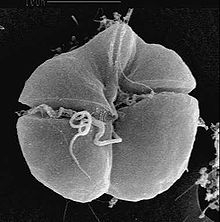| Karenia brevis | |
|---|---|

| |
| Scientific classification | |
| Domain: | Eukaryota |
| Clade: | Diaphoretickes |
| Clade: | SAR |
| Clade: | Alveolata |
| Phylum: | Myzozoa |
| Superclass: | Dinoflagellata |
| Class: | Dinophyceae |
| Order: | Gymnodiniales |
| Family: | Kareniaceae |
| Genus: | Karenia |
| Species: | K. brevis
|
| Binomial name | |
| Karenia brevis (Davis) G. Hansen et Moestrup
| |
Karenia brevis is a microscopic, single-celled, photosynthetic organism in the genus Karenia. It is a marine dinoflagellate commonly found in the waters of the Gulf of Mexico.[1] It is the organism responsible for the "Florida red tides" that affect the Gulf coasts of Florida and Texas in the U.S., and nearby coasts of Mexico. K. brevis has been known to travel great lengths around the Florida peninsula and as far north as the Carolinas.[2]
Each cell has two flagella that allow it to move through the water in a spinning motion. K. brevis is unarmored, and does not contain peridinin. Cells are between 20 and 40 μm in diameter. K. brevis naturally produces a suite of potent neurotoxins collectively called brevetoxins, which cause gastrointestinal and neurological problems in other organisms and are responsible for large die-offs of marine organisms and seabirds.[3]
- ^ Magaña, Hugo A.; Contreras, Cindy; Villareal, Tracy A. (August 2003). "A historical assessment of Karenia brevis in the western Gulf of Mexico". Harmful Algae. 2 (3): 163–171. CiteSeerX 10.1.1.173.1789. doi:10.1016/s1568-9883(03)00026-x. ISSN 1568-9883.
- ^ "About Florida Red Tides". myfwc.com. Retrieved 22 October 2018.
- ^ Ross, Cliff; Ritson-Williams, Raphael; Pierce, Richard; Bullington, J. Bradley; Henry, Michael; Paul, Valerie J. (February 2010). "Effects of the Florida Red Tide Dinoflagellate, Karenia brevis, on Oxidative Stress and Metamorphosis of Larvae of the Coral Porites astreoides". Harmful Algae. 9 (2): 173–9. doi:10.1016/j.hal.2009.09.001.